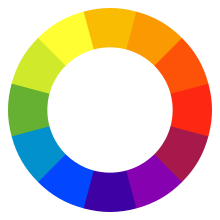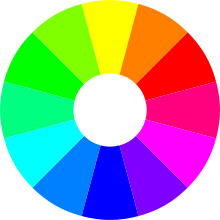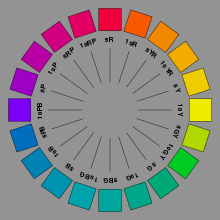335:
formulae, principles or guidelines for color combination with the aim being to predict or specify positive aesthetic response or "color harmony". Color wheel models have often been used as a basis for color combination principles or guidelines and for defining relationships between colors. Some theorists and artists believe juxtapositions of complementary color will produce strong contrast, a sense of visual tension as well as "color harmony"; while others believe juxtapositions of analogous colors will elicit positive aesthetic response. Color combination guidelines suggest that colors next to each other on the color wheel model (analogous colors) tend to produce a single-hued or monochromatic color experience and some theorists also refer to these as "simple harmonies". In addition, split complementary color schemes usually depict a modified complementary pair, with instead of the "true" second color being chosen, a range of analogous hues around it are chosen, i.e. the split complements of red are blue-green and yellow-green. A triadic color scheme adopts any three colors approximately equidistant around a color wheel model. Feisner and Mahnke are among a number of authors who provide color combination guidelines in greater detail.
188:
and the notion of color harmony is open to the influence of a range of different factors. These factors include individual differences (such as age, gender, personal preference, affective state, etc.) as well as cultural, sub-cultural and socially-based differences which gives rise to conditioning and learned responses about color. In addition, context always has an influence on responses about color and the notion of color harmony, and this concept is also influenced by temporal factors (such as changing trends) and perceptual factors (such as simultaneous contrast) which may impinge on human response to color. The following conceptual model illustrates this 21st century approach to color harmony:
343:
circumstances. For example, red has many different connotative and symbolic meanings from exciting, arousing, sensual, romantic and feminine; to a symbol of good luck; and also acts as a signal of danger. Such color associations tend to be learned and do not necessarily hold irrespective of individual and cultural differences or contextual, temporal or perceptual factors. It is important to note that while color symbolism and color associations exist, their existence does not provide evidential support for color psychology or claims that color has therapeutic properties.
76:
84:
68:
438:
426:
414:
334:
In addition, given that humans can perceive over 2.8 million different colors, it has been suggested that the number of possible color combinations is virtually infinite thereby implying that predictive color harmony formulae are fundamentally unsound. Despite this, many color theorists have devised
187:
It has been suggested that "Colors seen together to produce a pleasing affective response are said to be in harmony". However, color harmony is a complex notion because human responses to color are both affective and cognitive, involving emotional response and judgement. Hence, our responses to color
178:
The simplest and most stable harmony is that of analogous colors. It is composed of a root color and two or more nearby colors. It forms the basis for a color scheme, and in practice many color schemes are a combination of analogous and complementary harmonies in order to achieve both visual interest
338:
Color combination formulae and principles may provide some guidance but have limited practical application. This is because of the influence of contextual, perceptual and temporal factors which will influence how color/s are perceived in any given situation, setting or context. Such formulae and
161:
Similarly to split-complementary colors mentioned above, color triads involve three colors in a geometric relationship. Unlike split-complementary colors, however, all three colors are equidistant to one another on the color wheel in an equilateral triangle. The most common triads are the
342:
As early as the ancient Greek philosophers, many theorists have devised color associations and linked particular connotative meanings to specific colors. However, connotative color associations and color symbolism tends to be culture-bound and may also vary across different contexts and
103:
that have been developed. Different models yield different pairs of complementary colors and so forth, and the degree of harmony of sets derived from each color space is largely subjective. Despite the development of color models based on the physics of color production, such as
147:
Split-complementary colors are like complementary colors, except one of the complements is split into two nearby analogous colors. This maintains the tension of complementary colors while simultaneously introducing more visual interest with more variety.
299:
38:
refers to the property that certain aesthetically pleasing color combinations have. These combinations create pleasing contrasts and consonances that are said to be harmonious. These combinations can be of
487:
Hard, A. & Sivik, L. (2001). A theory of colors in combination - A descriptive model related to the NCS color-order system. Color
Research and Application, 26 (1), pp4-28.
95:
Several patterns have been suggested for predicting which sets of colors will be perceived as harmonious. One difficulty with codifying such patterns is the variety of
547:
O'Connor, Z. (2010). Colour psychology and colour therapy: Caveat emptor. Color
Research and Application, (Published online in 'EarlyView' in advance of print).
193:
339:
principles may be useful in fashion, interior and graphic design, but much depends on the tastes, lifestyle and cultural norms of the viewer or consumer.
124:(common to most early attempts at codifying color) has persisted among many artists and designers for selecting harmonious colors.
478:
Pointer, M. R. & Attridge, G.G. (1998). The number of discernible colors. Color
Research and Application, 23 (1), pp52-54.
55:
has it seen extensive codification. Artists and designers make use of these harmonies in order to achieve certain moods or
79:
The RGB (red–green–blue) color wheel, matching most technological processes, but exhibiting different complementary colors
430:
532:
442:
17:
139:. They create the most contrast and therefore greatest visual tension by virtue of how dissimilar they are.
418:
71:
The traditional RYB (red–yellow–blue) color wheel, often used for selecting harmonious colors in art
469:
O'Connor, Z. (2010). Color harmony revisited. Color
Research and Application, 35 (4), pp267-273.
311:) and the factors that influence positive aesthetic response to color: individual differences (
378:
52:
404:
353:
132:
113:
88:
47:. Color harmony has been a topic of extensive study throughout history, but only since the
40:
505:
Mahnke, F. (1996). Color, environment and human response. New York: John Wiley & Sons.
496:
Feisner, E. A. (2000). Colour: How to use colour in art and design. London: Laurence King.
8:
294:{\displaystyle {\text{Color harmony}}=f({\text{Col}}1,2,3,\dots ,n)\cdot (ID+CE+CX+P+T)}
460:
Burchett, K. E. (2002). Color harmony. Color
Research and Application, 27 (1), pp28-31.
393:
117:
528:
388:
44:
398:
167:
121:
109:
105:
562:
383:
323:) which include setting and ambient lighting; intervening perceptual effects (
315:) such as age, gender, personality and affective state; cultural experiences (
556:
163:
373:
363:
31:
524:
368:
358:
136:
100:
96:
48:
56:
75:
179:
through variety, chromatic stability, and tension through contrast.
83:
520:
67:
437:
425:
413:
91:
attempts to divide hues into equal perceptual differences.
307:) of the interaction between color/s (Col 1, 2, 3, …,
196:
293:
554:
112:, and those based on human perception, such as
43:, split-complementary colors, color triads, or
166:. From these primary colors are obtained the
142:
514:
331:) in terms of prevailing social trends.
82:
74:
66:
27:Aesthetically pleasing color combination
127:
14:
555:
303:Wherein color harmony is a function (
517:If it's Purple, Someone's Gonna Die
173:
24:
25:
574:
151:
135:exist opposite each other on the
436:
424:
412:
182:
541:
508:
499:
490:
481:
472:
463:
454:
288:
249:
243:
208:
13:
1:
448:
7:
346:
10:
579:
515:Bellantoni, Patti (2005).
143:Split-complementary colors
327:); and temporal effects (
156:
62:
319:); contextual effects (
295:
92:
80:
72:
379:Charles Albert Keeley
296:
86:
78:
70:
53:Scientific Revolution
445:at Wikimedia Commons
433:at Wikimedia Commons
421:at Wikimedia Commons
405:On Vision and Colors
354:Complementary colors
194:
133:Complementary colors
128:Complementary colors
41:complementary colors
89:Munsell color wheel
431:Chromatic diagrams
394:Theory of painting
291:
120:, the traditional
93:
81:
73:
441:Media related to
429:Media related to
417:Media related to
389:Subtractive color
214:
200:
16:(Redirected from
570:
548:
545:
539:
538:
512:
506:
503:
497:
494:
488:
485:
479:
476:
470:
467:
461:
458:
440:
428:
416:
300:
298:
297:
292:
215:
212:
201:
198:
174:Analogous colors
168:secondary colors
45:analogous colors
21:
578:
577:
573:
572:
571:
569:
568:
567:
553:
552:
551:
546:
542:
535:
513:
509:
504:
500:
495:
491:
486:
482:
477:
473:
468:
464:
459:
455:
451:
410:
399:HSV color space
349:
211:
197:
195:
192:
191:
185:
176:
159:
154:
145:
130:
122:RYB color model
65:
28:
23:
22:
15:
12:
11:
5:
576:
566:
565:
550:
549:
540:
533:
507:
498:
489:
480:
471:
462:
452:
450:
447:
446:
434:
422:
409:
408:
401:
396:
391:
386:
384:Additive color
381:
376:
371:
366:
361:
356:
350:
348:
345:
290:
287:
284:
281:
278:
275:
272:
269:
266:
263:
260:
257:
254:
251:
248:
245:
242:
239:
236:
233:
230:
227:
224:
221:
218:
210:
207:
204:
184:
181:
175:
172:
164:primary colors
158:
155:
153:
152:Color polygons
150:
144:
141:
129:
126:
64:
61:
26:
9:
6:
4:
3:
2:
575:
564:
561:
560:
558:
544:
536:
534:0-240-80688-3
530:
526:
522:
518:
511:
502:
493:
484:
475:
466:
457:
453:
444:
439:
435:
432:
427:
423:
420:
415:
411:
407:
406:
402:
400:
397:
395:
392:
390:
387:
385:
382:
380:
377:
375:
372:
370:
367:
365:
362:
360:
357:
355:
352:
351:
344:
340:
336:
332:
330:
326:
322:
318:
314:
310:
306:
301:
285:
282:
279:
276:
273:
270:
267:
264:
261:
258:
255:
252:
246:
240:
237:
234:
231:
228:
225:
222:
219:
216:
205:
202:
199:Color harmony
189:
180:
171:
169:
165:
149:
140:
138:
134:
125:
123:
119:
115:
111:
107:
102:
98:
90:
85:
77:
69:
60:
58:
54:
50:
46:
42:
37:
36:color harmony
33:
19:
18:Color harmony
543:
516:
510:
501:
492:
483:
474:
465:
456:
443:Color spaces
403:
374:Color mixing
364:Color scheme
341:
337:
333:
328:
324:
320:
316:
312:
308:
304:
302:
190:
186:
183:Relationship
177:
160:
146:
131:
101:color models
97:color spaces
94:
35:
32:color theory
29:
525:Focal Press
419:Colorwheels
369:Color field
359:Color wheel
137:color wheel
49:Renaissance
449:References
118:CIE L*a*b*
57:aesthetics
247:⋅
235:…
557:Category
521:Elsevier
347:See also
51:and the
114:Munsell
531:
157:Triads
563:Color
63:Types
529:ISBN
116:and
108:and
99:and
87:The
213:Col
110:CMY
106:RGB
30:In
559::
527:.
523:,
519:.
321:CX
317:CE
313:ID
170:.
59:.
34:,
537:.
329:T
325:P
309:n
305:f
289:)
286:T
283:+
280:P
277:+
274:X
271:C
268:+
265:E
262:C
259:+
256:D
253:I
250:(
244:)
241:n
238:,
232:,
229:3
226:,
223:2
220:,
217:1
209:(
206:f
203:=
20:)
Text is available under the Creative Commons Attribution-ShareAlike License. Additional terms may apply.


